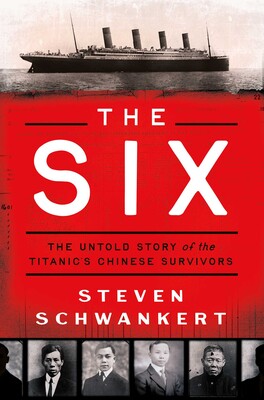A Q&A with Steven Schwankert, Author of The Six
Posted: May 30th, 2025 | No Comments »Steven Schwakert’s new book is The Six (Simon and Schuster/The History Press) and below is my short Q&A with him on the story, the book, the documentary he was involved in slightly earlier, and its process to publication….
When RMS Titanic sank on a cold night in 1912, barely seven hundred people escaped with their lives. Among them were six Chinese men. Arriving in New York, these six were met with suspicion and slander. Fewer than twenty-four hours later, they were expelled from the country and vanished. When historian Steven Schwankert first stumbled across the fact that eight Chinese nationals were onboard, of whom all but two survived, he couldn’t believe that there could still be untold personal histories from the Titanic. Now, at last, their story can be told. The result of meticulous research, a dogged investigation, and interviews with family members, The Six is an epic journey across continents that reveals the full story of these six forgotten survivors. Who were Ah Lam, Chang Chip, Cheong Foo, Fang Lang (or Fong Wing Sun), Lee Bing, and Ling Hee? Professional mariners, their incredible journeys reveal an overlooked, but all-too-common, experience of inequality and discrimination. The Titanic continues to reveal a multitude of secrets, and the lives of these six men add a layer of humanity and nuance to one of the most storied shipwrecks in history.
PF: Tell us the basic story in 200 words?
SS: Titanic had about 1,500 passengers on board, not including officers and crew. Of those, eight were Chinese men, most likely from Guangdong, maybe Hong Kong. Of those eight, six survived the great ship’s sinking, five in lifeboats, one hanging on to debris in the water. It’s a small sample size, but a very high survival rate, especially for third-class male passengers who were likely the most foreign-looking on board. How did they survive? Who were they? Why were they on Titanic? What happened to them afterward, and why do we know so little about them? All of those questions bothered me, and the book is my attempt to answer them.
PF: Was this a book, or a doc, first – what’s been the creative trajectory?
SS: I only think in terms of books, but I have an old friend and creative partner in Arthur Jones, who is a gifted documentary filmmaker. We’ve worked on two projects now, first Poseidon, about a Royal Navy submarine sunk off the cost of Shandong province, and now The Six. Arthur does a wonderful job of putting my semi-obsessive quests on film. We research the topic together, then we each produce our own end products. We don’t always agree, and that’s fine.
PF: I know the doc was popular in China, the book should be too – why have Chinese viewers rallied to this tale?
SS: Both the documentary and a simplified edition of the book have been out in China since 2021. The story is very popular, but neither the documentary nor the book was a commercial hit.
The story of Titanic survives not because of a large hunk of steel at the bottom of the ocean. It’s because people want to put themselves into it. Would I have surrendered my seat in a lifeboat? Would I have stayed with my partner and gone down with the ship? Before “The Six,” the Chinese weren’t part of the story, except in the background of James Cameron’s film. Now they are as much part of it as anyone else. Cameron’s “Titanic” was an enormous hit in China in the late 1990s; now people in China can see themselves in it the same way others can.
PF: Telling stories of global historical importance and finding a Chinese angle that hasn’t been written about before is a sure-fire way to excite Chinese publishers – any other ideas in the same vein?
SS: There are an absolute ton. The Chinese roots of reggae has kind of been done, but in a very sort of Brooklyn, hipster way. The people that did the Lisbon Maru documentary followed in our footsteps, and its popularity and success show that the audience is into that kind of story. Jim Zimmernan’s “The Peking Express” has appealed to Chinese audiences and publishers. It’s not about a wealth or dearth of material, it’s about whether those stories can be researched and presented fully.
PF: With a story like this how do you balance the different demands of curious English language readers and those in China – are their interests in the characters different, perhaps more about their origins and how they came to be on the Titanic, whereas in the West perhaps it’s more what happened to them?
SS: I never worried about that. Of course, readers in different countries and cultures won’t have the same interests, but ultimately, they want to understand characters and be able to relate to them. A reader always compares themselves to a character, it’s our way of understanding. Presenting the character accurately, authentically, and fairly will satisfy just about any reader, no matter their culture or language.
PF: You’ve done submarines sunk off the China coast and now Titanic – what’s next?
SS: Next up is another China shipwreck book, the one that Arthur and I started working on when we veered off in a Titanic direction. There’s a Chinese archaeology mystery at which I might want to take a swing. There’s a Chinese-American story that keeps me up at night, one that will really upset a lot of people, and that just makes me want to do it more. I’m also committed to telling the story of New Jersey’s worst shipwreck, the Powhattan, which went down in 1854. So, lots.

Leave a Reply